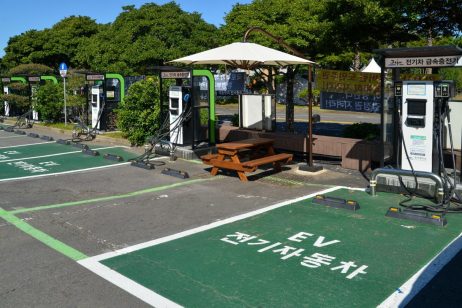At the turn of the 20th century, New York City faced a crisis. Around 100,000 horses used for transportation produced 2.5 million pounds of manure each day. The waste attracted swarms of flies and, as it dried, turned into dust that spread across the city. The streets became breeding grounds for diseases such as typhoid fever. An international conference was held in New York to discuss solutions, but the problem remained intractable.
The crisis was eventually resolved when an unexpected hero emerged: the automobile. Initially, the advent of gasoline-powered cars was seen as a public health breakthrough. However, more than a century later, combustion engine vehicles have become a leading source of air pollution and climate emissions.
The combustion engine vehicle’s transformation from hero to villain underscores the fact that sound transport policy requires constant innovation. Leaders of my home country, South Korea, and their counterparts around the world, must pursue bold solutions for the emissions crisis of today.
Vehicle emissions pose a threat to current and future generations. In South Korea, road transport accounts for approximately 14 percent of total greenhouse gas emissions, originating in large part from combustion engine vehicles. Exhaust fumes from gasoline and diesel engines are today’s equivalent of New York City’s manure crisis in the early 1900s.
Between 2013 and 2023, damages and recovery costs from climate disasters in South Korea totaled an estimated $12.24 billion. As the climate crisis continues to intensify, communities around the world can expect growing threats from extreme weather events such as torrential rains, typhoons, and heatwaves.
Tailpipes emit particulate matter, ozone, and nitrogen oxides, all of which threaten our health. Air pollution from car exhaust is associated with increased levels of lung cancer, heart disease, Alzheimer’s and other serious illnesses. Our climate and health are deteriorating in parallel.
The fastest way to reduce greenhouse gas emissions from road transport is to phase out combustion engine vehicles, including by replacing them with electric vehicles (EVs). Over the course of their life cycles, internal combustion engine vehicles (ICE) emit roughly twice as much CO2 as EVs, according to the International Energy Agency.
Yet alarmingly, South Korea’s adoption of EVs is slowing. In 2022, 170,000 zero-emission vehicles (ZEVs) were registered nationwide, but this figure fell to 150,000 vehicles in 2024. By the end of 2024, ZEVs made up only about 9 percent of new vehicle sales in South Korea. Barriers such as limited charging infrastructure, shrinking subsidies, and widespread misconceptions about EVs continue to hinder adoption.
Transport sector emissions in South Korea remain stubbornly high, and decreased only 1.4 percent between 2018 and 2023, according to research from South Korea’s Green Transport Movement, Green Energy Strategy Institute, and Plan 1.5. At this pace, South Korea is on track to overshoot its 2030 emissions reduction target dramatically, the research shows.
The new government must act decisively and immediately to reduce emissions from transport. Greenpeace urges that the government aim for a complete phase-out of combustion engine vehicles by 2030, in line with the Paris Climate Agreement.
South Korea’s government must also end fossil fuel subsidies that artificially reduce the cost of owning combustion engine vehicles. Since 2021, fuel tax cuts have been extended 15 times. Between 2021 and 2023, the cuts resulted in revenue loss of more than $12 billion, funds that could have supported public transportation and sustainable infrastructure.
With South Korea’s presidential election behind us, it is essential that the country’s new administration demonstrate bold leadership and a long-term perspective. The government must hold polluters accountable. The new government should support the economy by creating green jobs and offering incentives for businesses to decarbonize.
A major transition is necessary to ensure clean streets for years to come and to create conditions for the next generation to innovate further. Governments should take on this mission without hesitation. Ultimately, the climate crisis is not a problem that can be ignored or swept away like manure on a road.
Source link : View Article
Author
-

Greenpeace is an independent global campaigning network that acts to change attitudes and behavior, to protect and conserve the environment and to promote peace. It comprises 26 independent national/regional Greenpeace organizations with presence in over 55 countries across Europe, Africa, the Americas, Asia and the Pacific, as well as a coordinating and supporting organisation, Greenpeace International.



